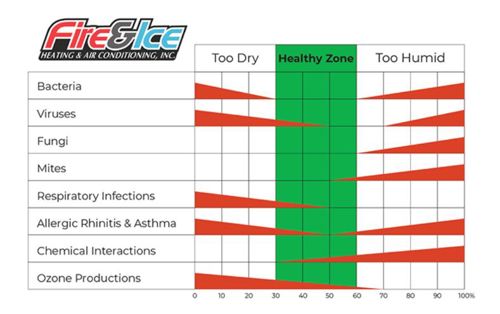
Problems Caused by High Humidity
Extreme summer temperatures result in increased humidity. When the air moisture is too high, your house begins to feel extremely hot and stuffy. High humidity also attracts mold and mildew growth.
Exposure to these contaminants triggers asthma attacks, allergies, and other respiratory illnesses. Humid air also damages your paint, furniture, and wallpaper and results in damp odors. Signs of high moisture levels include condensation on the windows and pest infestation.

Problems Caused by Low Humidity
On the other hand, low humidity causes dry skin, nose and throat itchiness, and damage to wood surfaces. You can measure your home's humidity using a hygrometer.
The ideal range should be around 30% to 50%. If it's below or above this range, use the following tips to manage your humidity levels.
HOW TO LOWER INDOOR HUMIDITY IN THE SUMMER
IMPROVE YOUR HOME'S VENTILATION
Properly ventilating your house can help resolve moisture problems. Open your windows and doors if the humidity inside is lower or equal to the outdoors. This allows natural circulation of air, redirecting warm, moist air outside and letting in fresh air. Remember to turn off our HVAC unit once you open the windows to avoid energy waste. If the humidity level is very high outside, keep your windows and doors tightly closed. Caulk and weather-strip your windows and doors to reduce air leakage.
USE YOUR AIR CONDITIONER
An air conditioner helps remove both moisture and warmth from your indoor air. The AC draws out warm and moist indoor air and then blows it over cold evaporator coils. The refrigerant absorbs the heat and causes the moisture to condense. It then flows to the drip pan and drains out of the house. The AC will blow back cool and less humid air into the home. Schedule regular professional maintenance to maximize your AC's effectiveness. Also, change the air filters more often. When the air filters clog, they limit airflow, and your air can get more humid.
INSTALL DEHUMIDIFIERS
The best way to lower your indoor air moisture is by installing a whole-house dehumidifier, especially if you live in a highly humid area. Call a technician to integrate the unit directly into your HVAC system. The dehumidifier draws air from the return duct and then blows it over a very cold coil. The water vapor will then condense and drip into the collection tank underneath. You will need to empty the condensate drain once it fills up. Alternatively, you can purchase a portable dehumidifier unit to resolve minor humidity issues.
Install a whole-house humidifier when your indoor humidity level drops below the standard. These units add moisture to the air. Winter is typically the time when you would most need to run a humidifier, but you can also use one in the summer to help alleviate allergy symptoms.
USE EXHAUST FANS
Install exhaust fans in the kitchen and washroom to reduce excess humidity in your house. They extract moisture, fumes, and odors produced when cooking or showering and vent them outside through ventilation ducts. The fans' movement increases airflow within your home, which aids in moisture evaporation. The increased air circulation will also help distribute conditioned air from your AC evenly. This is very beneficial for rooms that feel stuffy. Keep the exhaust fan on for an extra 20 minutes after cooking or taking a shower to draw out all moisture.
DRY YOUR LAUNDRY OUTSIDE
When you hang clothes on an indoor drying rack, the evaporating moisture goes directly into the air, increasing the humidity level in your house, especially in summer. So, if you have clothes that you can't put in a drier, hang them outside in the sun. If you can't hang clothes outside, you will need to run a dehumidifier alongside the drier. Note that a drier produces heat and steam while in operation. While it vents most moisture outside, a considerable amount remains inside your house.
FIX LEAKING PIPES
Leaking pipes cause condensation and excess moisture accumulation that can raise the humidity level of your indoor air. Therefore, fix any pipe or faucet leaks as soon as they occur. While it might be challenging to spot minor leaks, check for signs like stained walls, increased water bills, and wet spots. Wrap exposed cold-water pipes with an insulator to eliminate cool surfaces that can lead to the formation of condensation.
USE CHARCOAL BRIQUETTES
You can use charcoal briquettes to absorb moisture and odors from your house. Take a large can, punch holes on the sides and the lid, add charcoal, and close it. Place the can in the most humid spaces, like the basement, bathroom, kitchen, or attic. This option will only work for small rooms with minor humidity issues, and you will need to replace the charcoal every two to three months.
RELOCATE YOUR HOUSE PLANTS
You can use plants to humidify or dehumidify your house. The spider, jade, areca palm, Boston fern, and rubber plant are the best humidifying options. They absorb water from the soil, and it evaporates through their leaves' pores, adding moisture to the air. If you are struggling with high humidity issues, limit the number of plants in your house or move them outside to the patio. If you must keep plants inside, place them in well-ventilated rooms. Some dehumidifying options you can consider include the air plant, aloe Vera, peace lily, and peperomia. These plants draw out moisture and add more oxygen, improving indoor air quality.
TAKE SHORT COOL SHOWERS
Long hot showers increase the humidity level in the house. At times it gets so high that you can see condensation on the mirrors and other surfaces in the bathroom. The humidity can quickly spread to other areas of the home if you leave the bathroom door open. Lowering the temperature of your shower by a few degrees will help minimize the amount of steam produced. Cutting your shower time and using a low-flow showerhead will also reduce indoor air moisture.
CLEAN YOUR GUTTERS
If you neglect your gutters, leaves and other debris may clog the downspout. Water begins to collect there. When it rains, the water will flow out of the gutters to the side of the house. A small crack in the foundation will allow water into the basement, increasing indoor humidity levels. You can prevent this by inspecting and cleaning the gutters often. Also, channel the downspout at least 6 feet away from the house.
HOW TO INCREASE INDOOR HUMIDITY LEVELS IN THE WINTER
INSTALL HUMIDIFIERS
Using a humidifier is one of the most effective ways to add moisture to the air during the winter. Portable options are great for targeting specific areas, while whole-house humidifiers ensure your entire home stays comfortable. They're an ideal solution when learning how to control indoor humidity during the colder months.
UPGRADE DOORS, WINDOWS, AND WEATHER STRIPPING
Sealing gaps around doors and windows with weather stripping helps retain heat and prevent dry air from entering your home. Upgrading to energy-efficient doors and windows can also help stabilize indoor moisture levels. These changes are excellent for anyone looking to learn how to manage humidity in the house more effectively.
USE DIFFUSERS
Diffusers release pleasant scents and add small amounts of moisture to the air. They are particularly useful for increasing humidity in smaller spaces like bedrooms or home offices. This simple tool is a practical way to increase humidity in the home while enjoying aromatherapy.
ADD INDOOR PLANTS & FLOWERS
Houseplants naturally add moisture to the air through transpiration, making them a great way to combat dryness. Spider plants, peace lilies, and other high-humidity plants are particularly effective. Besides improving humidity, they enhance your home's atmosphere with greenery.
BOIL WATER ON THE STOVE
Boiling water on the stove releases steam into the air, which helps add moisture to your living space. This method is especially useful in kitchens and surrounding areas during the colder months. It's a simple and practical way to address dryness using everyday activities.
LEAVE THE BATHROOM DOOR OPEN
After a hot shower, leave the bathroom door open to let steam circulate through your home. This allows the moisture to spread naturally into adjacent spaces. It's an easy and cost-free way to make use of the humidity created in your bathroom.
SEEK PROFESSIONAL HUMIDITY CONTROL SERVICES
Both high humidity and low humidity issues adversely affect your home comfort. You can reduce humidity issues by making simple home adjustments. If these solutions fail to work, you will have to install a whole-house humidifier or dehumidifier. Have a professional set up the unit. They will recommend a suitable option for your needs and consider the humidifier's drainage and location to maximize its efficiency. After installation, you will need to schedule regular maintenance to keep the unit working at peak performance.
If you are struggling with humidity issues, consult ARS today. Call our team at 866-399-2885 today!




